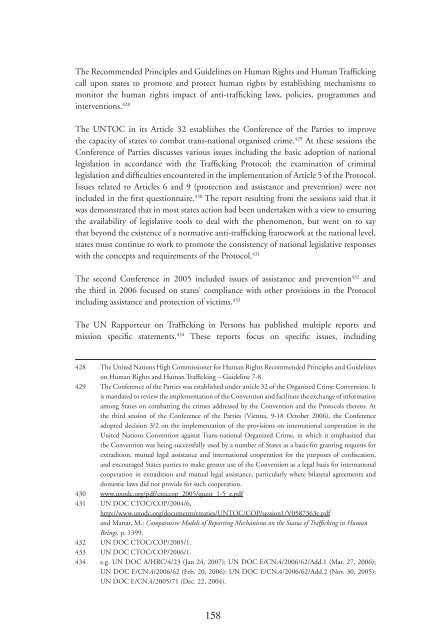Trafficking in human beings: human rights and ... - unesdoc - Unesco
Trafficking in human beings: human rights and ... - unesdoc - Unesco
Trafficking in human beings: human rights and ... - unesdoc - Unesco
Create successful ePaper yourself
Turn your PDF publications into a flip-book with our unique Google optimized e-Paper software.
The Recommended Pr<strong>in</strong>ciples <strong>and</strong> Guidel<strong>in</strong>es on Human Rights <strong>and</strong> Human Traffi ck<strong>in</strong>g<br />
call upon states to promote <strong>and</strong> protect <strong>human</strong> <strong>rights</strong> by establish<strong>in</strong>g mechanisms to<br />
monitor the <strong>human</strong> <strong>rights</strong> impact of anti-traffi ck<strong>in</strong>g laws, policies, programmes <strong>and</strong><br />
<strong>in</strong>terventions. 428<br />
The UNTOC <strong>in</strong> its Article 32 establishes the Conference of the Parties to improve<br />
the capacity of states to combat trans-national organised crime. 429 At these sessions the<br />
Conference of Parties discusses various issues <strong>in</strong>clud<strong>in</strong>g the basic adoption of national<br />
legislation <strong>in</strong> accordance with the Traffi ck<strong>in</strong>g Protocol; the exam<strong>in</strong>ation of crim<strong>in</strong>al<br />
legislation <strong>and</strong> diffi culties encountered <strong>in</strong> the implementation of Article 5 of the Protocol.<br />
Issues related to Articles 6 <strong>and</strong> 9 (protection <strong>and</strong> assistance <strong>and</strong> prevention) were not<br />
<strong>in</strong>cluded <strong>in</strong> the fi rst questionnaire. 430 The report result<strong>in</strong>g from the sessions said that it<br />
was demonstrated that <strong>in</strong> most states action had been undertaken with a view to ensur<strong>in</strong>g<br />
the availability of legislative tools to deal with the phenomenon, but went on to say<br />
that beyond the existence of a normative anti-traffi ck<strong>in</strong>g framework at the national level,<br />
states must cont<strong>in</strong>ue to work to promote the consistency of national legislative responses<br />
with the concepts <strong>and</strong> requirements of the Protocol. 431<br />
The second Conference <strong>in</strong> 2005 <strong>in</strong>cluded issues of assistance <strong>and</strong> prevention 432 <strong>and</strong><br />
the third <strong>in</strong> 2006 focused on states’ compliance with other provisions <strong>in</strong> the Protocol<br />
<strong>in</strong>clud<strong>in</strong>g assistance <strong>and</strong> protection of victims. 433<br />
The UN Rapporteur on Traffi ck<strong>in</strong>g <strong>in</strong> Persons has published multiple reports <strong>and</strong><br />
mission specifi c statements. 434 These reports focus on specifi c issues, <strong>in</strong>clud<strong>in</strong>g<br />
428 The United Nations High Commissioner for Human Rights Recommended Pr<strong>in</strong>ciples <strong>and</strong> Guidel<strong>in</strong>es<br />
on Human Rights <strong>and</strong> Human Traffi ck<strong>in</strong>g – Guidel<strong>in</strong>e 7-8.<br />
429 The Conference of the Parties was established under article 32 of the Organized Crime Convention. It<br />
is m<strong>and</strong>ated to review the implementation of the Convention <strong>and</strong> facilitate the exchange of <strong>in</strong>formation<br />
among States on combatt<strong>in</strong>g the crimes addressed by the Convention <strong>and</strong> the Protocols thereto. At<br />
the third session of the Conference of the Parties (Vienna, 9-18 October 2006), the Conference<br />
adopted decision 3/2 on the implementation of the provisions on <strong>in</strong>ternational cooperation <strong>in</strong> the<br />
United Nations Convention aga<strong>in</strong>st Trans-national Organized Crime, <strong>in</strong> which it emphasized that<br />
the Convention was be<strong>in</strong>g successfully used by a number of States as a basis for grant<strong>in</strong>g requests for<br />
extradition, mutual legal assistance <strong>and</strong> <strong>in</strong>ternational cooperation for the purposes of confi scation,<br />
<strong>and</strong> encouraged States parties to make greater use of the Convention as a legal basis for <strong>in</strong>ternational<br />
cooperation <strong>in</strong> extradition <strong>and</strong> mutual legal assistance, particularly where bilateral agreements <strong>and</strong><br />
domestic laws did not provide for such cooperation.<br />
430 www.unodc.org/pdf/ctoccop_2005/quest_1-5_e.pdf<br />
431 UN DOC CTOC/COP/2004/6,<br />
http://www.unodc.org/documents/treaties/UNTOC/COP/session1/V0587363e.pdf<br />
<strong>and</strong> Mattar, M.: Comparative Models of Report<strong>in</strong>g Mechanisms on the Status of Traffi ck<strong>in</strong>g <strong>in</strong> Human<br />
Be<strong>in</strong>gs, p. 1399.<br />
432 UN DOC CTOC/COP/2005/1.<br />
433 UN DOC CTOC/COP/2006/1.<br />
434 e.g. UN DOC A/HRC/4/23 (Jan 24, 2007); UN DOC E/CN.4/2006/62/Add.1 (Mar. 27, 2006);<br />
UN DOC E/CN.4/2006/62 (Feb. 20, 2006); UN DOC E/CN.4/2006/62/Add.2 (Nov. 30, 2005);<br />
UN DOC E/CN.4/2005/71 (Dec. 22, 2004).<br />
158

















